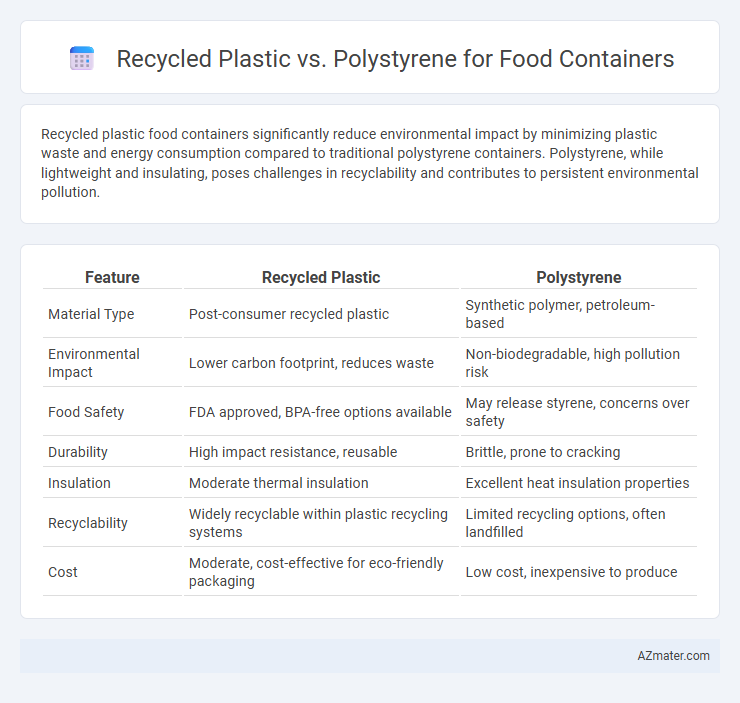Recycled plastic food containers significantly reduce environmental impact by minimizing plastic waste and energy consumption compared to traditional polystyrene containers. Polystyrene, while lightweight and insulating, poses challenges in recyclability and contributes to persistent environmental pollution.
Table of Comparison
| Feature | Recycled Plastic | Polystyrene |
|---|---|---|
| Material Type | Post-consumer recycled plastic | Synthetic polymer, petroleum-based |
| Environmental Impact | Lower carbon footprint, reduces waste | Non-biodegradable, high pollution risk |
| Food Safety | FDA approved, BPA-free options available | May release styrene, concerns over safety |
| Durability | High impact resistance, reusable | Brittle, prone to cracking |
| Insulation | Moderate thermal insulation | Excellent heat insulation properties |
| Recyclability | Widely recyclable within plastic recycling systems | Limited recycling options, often landfilled |
| Cost | Moderate, cost-effective for eco-friendly packaging | Low cost, inexpensive to produce |
Introduction: The Debate on Food Container Materials
Recycled plastic and polystyrene are two prevalent materials used for food containers, each presenting distinct advantages and environmental concerns. Recycled plastic offers enhanced sustainability through reduced waste and resource conservation but may raise questions about chemical safety and durability. Polystyrene is lightweight and cost-effective, yet its environmental impact and non-biodegradability remain significant challenges in the food packaging industry.
Environmental Impact: Recycled Plastic vs Polystyrene
Recycled plastic food containers significantly reduce environmental impact by diverting waste from landfills and lowering greenhouse gas emissions compared to conventional materials. Polystyrene, often non-biodegradable and difficult to recycle, contributes extensively to pollution and marine litter, posing greater ecological risks. Choosing recycled plastics improves resource efficiency and supports circular economy initiatives in food packaging.
Safety and Health Concerns
Recycled plastic food containers often raise safety concerns due to potential contamination from previous uses and the presence of harmful chemicals like BPA or phthalates, which can leach into food. Polystyrene containers, particularly expanded polystyrene (EPS), pose health risks through styrene migration, especially when exposed to heat or fatty foods, potentially causing neurological and carcinogenic effects. Both materials require strict regulatory compliance and consumer awareness to minimize exposure to toxic substances and ensure food safety.
Food Preservation and Quality
Recycled plastic food containers offer enhanced food preservation by reducing permeability to moisture and oxygen, thus extending shelf life and maintaining freshness better than polystyrene. Polystyrene containers, while lightweight and cost-effective, tend to have higher gas permeability and poor insulation properties, which can compromise food quality and temperature stability. Choosing recycled plastic supports both superior barrier performance and environmental sustainability in food packaging.
Cost Effectiveness and Scalability
Recycled plastic food containers offer greater cost-effectiveness due to lower raw material expenses and reduced environmental fees compared to polystyrene, which often incurs higher production costs and recycling challenges. The scalability of recycled plastic is enhanced by widespread availability and established recycling infrastructures, enabling large-scale manufacturing to meet growing demand. Polystyrene's limited recyclability and fluctuating material costs hinder its economic feasibility and scalability in food container applications.
Durability and Strength Comparison
Recycled plastic food containers offer enhanced durability with high resistance to impact, bending, and cracking compared to polystyrene, which is more brittle and prone to breaking under stress. The molecular structure of recycled plastics, often comprising polyethylene terephthalate (PET) or high-density polyethylene (HDPE), provides superior tensile strength and flexibility, making them ideal for repeated use and long-term storage. Polystyrene containers, while lightweight and inexpensive, typically lack the mechanical robustness necessary for durability, limiting their application to single-use scenarios.
Recycling and End-of-Life Solutions
Recycled plastic food containers often benefit from established curbside recycling programs, enabling efficient material recovery and reducing landfill waste. Polystyrene containers, particularly expanded polystyrene (EPS), face significant recycling challenges due to contamination and low economic viability, resulting in limited recycling infrastructure. End-of-life solutions for recycled plastic emphasize circular economy models, while polystyrene frequently relies on landfill disposal or energy recovery through incineration.
Regulatory Compliance and Food Safety Standards
Recycled plastic food containers must meet FDA and EFSA regulations ensuring no harmful chemical migration, while polystyrene containers comply with specific food contact materials standards like FDA 21 CFR 177.1640. Both materials are subject to stringent testing for contaminants, migration limits, and temperature resistance to guarantee consumer safety. Regulatory compliance ensures recycled plastics are free from residual toxins, whereas polystyrene's inert nature offers a reliable barrier but raises concerns over styrene monomer migration under certain conditions.
Consumer Perception and Market Trends
Consumer perception of recycled plastic food containers favors environmental sustainability and eco-friendly branding, driving increased demand in health-conscious and green markets. Polystyrene, despite its low cost and effective insulation properties, faces negative perceptions due to concerns over its non-biodegradability and potential health risks. Market trends indicate a significant shift towards recycled plastic containers as regulatory pressures and consumer preferences prioritize recyclable and less toxic packaging materials.
Conclusion: Choosing the Best Material
Recycled plastic offers enhanced environmental benefits with reduced carbon footprint and supports circular economy initiatives, making it a sustainable choice for food containers. Polystyrene provides excellent insulation and lightweight properties but has limited recyclability and contributes significantly to plastic pollution. Selecting recycled plastic balances durability, safety, and eco-friendliness, positioning it as the preferable material for modern food packaging solutions.

Infographic: Recycled plastic vs Polystyrene for Food container
 azmater.com
azmater.com